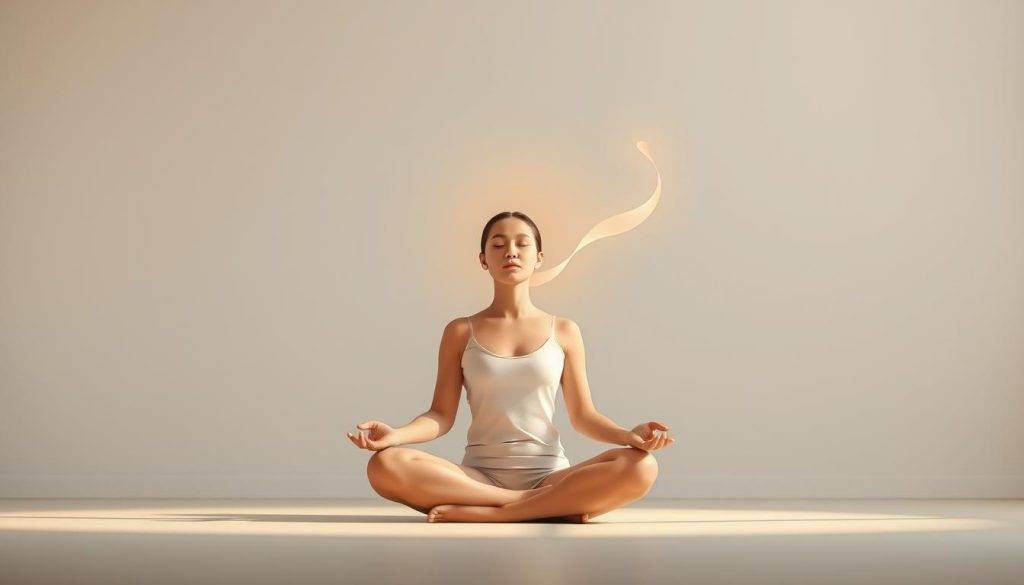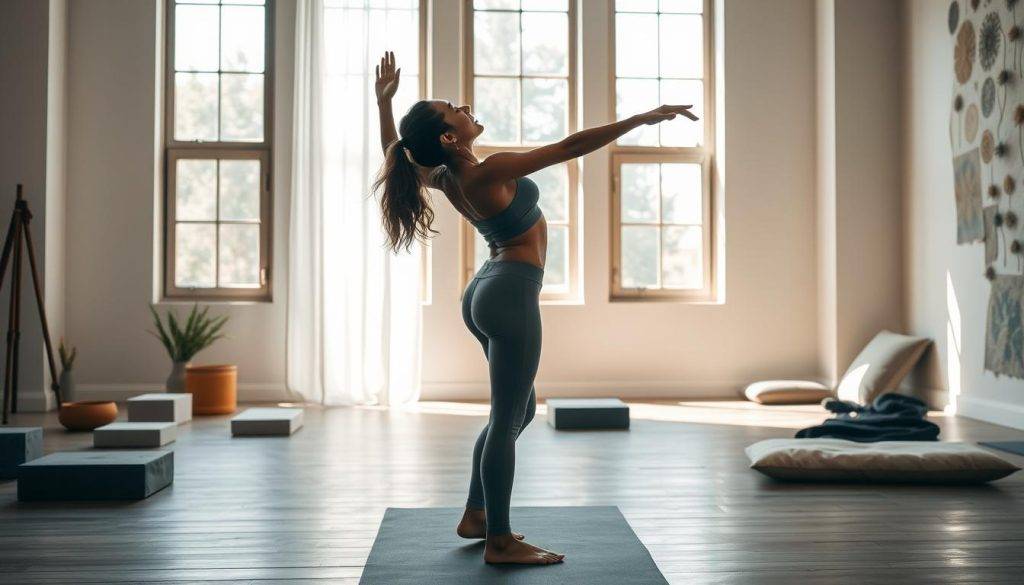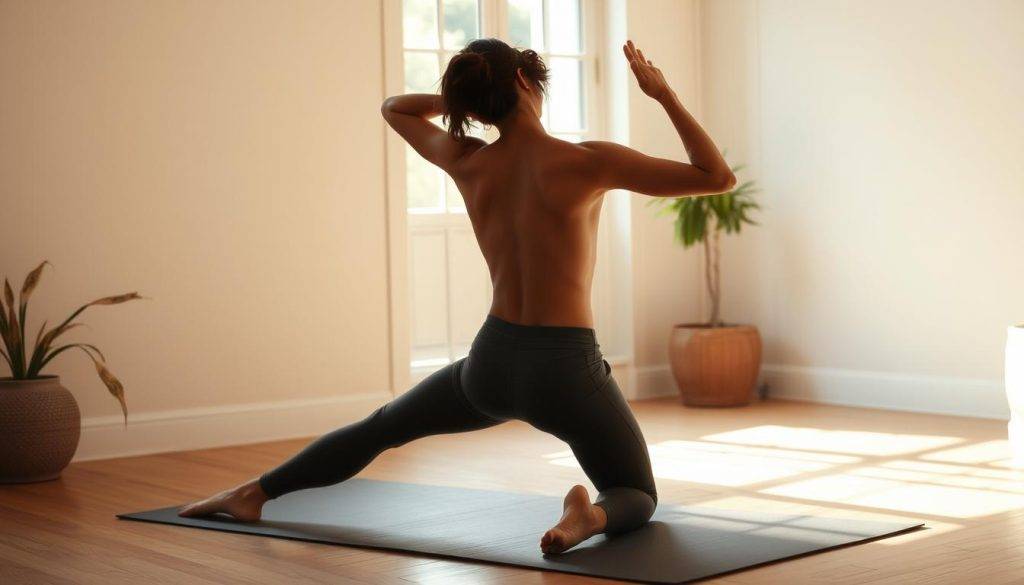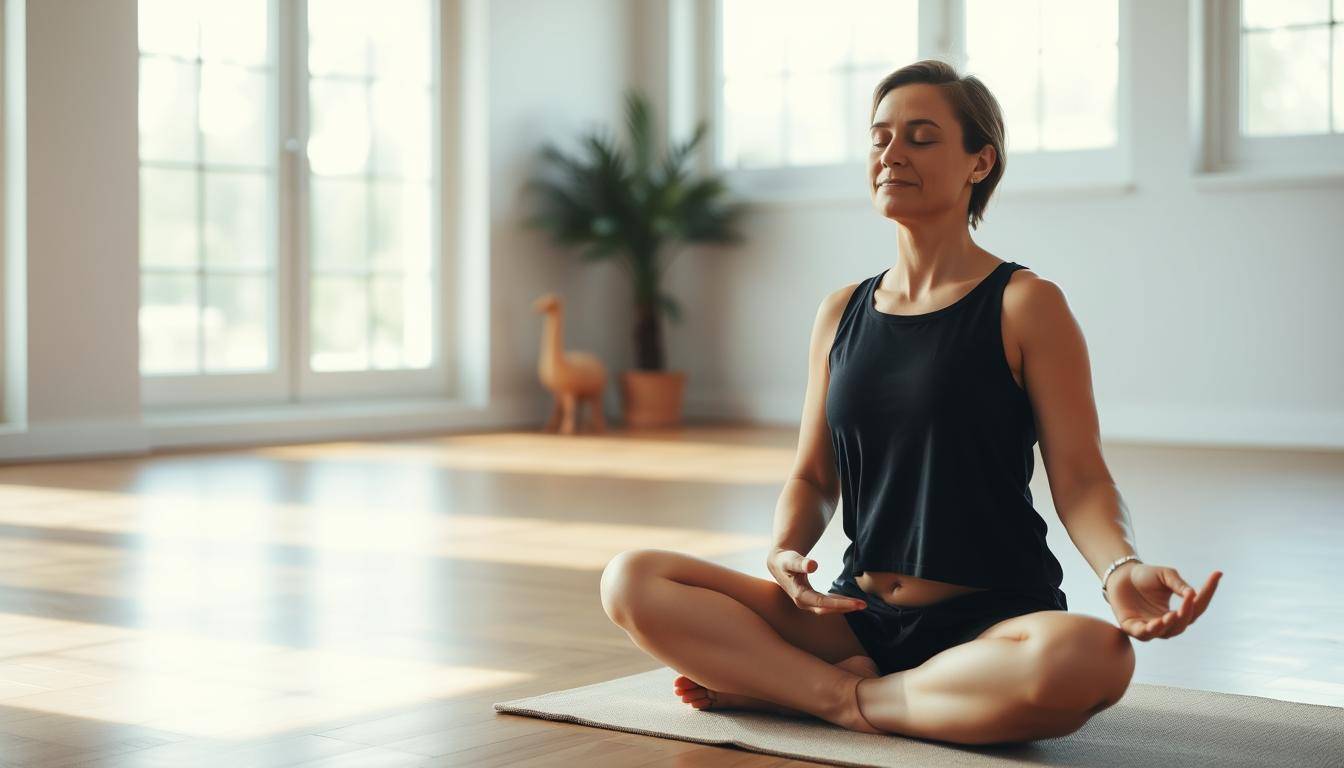“The soul heals in quiet, and the body heals through movement.” – Maya Angelou’s words capture the essence of what modern science confirms: physical motion can dissolve tension and restore harmony between the body and mind. This article explores how intentional, gentle practices reconnect you with your physical sensations to combat daily stressors.
When anxiety strikes, the body often bears the brunt—tight shoulders, shallow breathing, or restless legs. Research from the Office of Well-Being shows that even brief moments of mindful movement can interrupt this cycle. By focusing on subtle shifts—like grounding your feet or softening your head—you activate the parasympathetic nervous system, signaling safety to your brain.
Experts like Jen Graham emphasize that these techniques require no equipment or hours of practice. A five-minute session can reset your mental health, offering relief from symptoms like racing thoughts or muscle stiffness. The key lies in cultivating awareness of how stress manifests physically—a skill anyone can develop.
In the following sections, you’ll discover practical methods to release stored tension, improve relaxation, and strengthen the mind-body connection. Whether you’re new to this approach or seeking fresh strategies, these tools empower you to reclaim calm—one intentional breath at a time.
Key Takeaways
- Physical movement directly impacts emotional well-being by calming the nervous system.
- Short, daily sessions without equipment can significantly reduce anxiety symptoms.
- Body awareness techniques help identify and release hidden tension patterns.
- Controlled breathing enhances relaxation and mental clarity during stressful moments.
- Consistent practice builds resilience against future stress triggers.
Introduction to Somatic Stress Relief
Your shoulders tighten during deadlines. Your breath quickens before tough conversations. These physical reactions aren’t random—they’re your body sounding an alarm. Somatic stress relief focuses on decoding these signals through intentional movements and heightened awareness.
Understanding Stress, Anxiety, and Their Physical Impact

Stress doesn’t just live in your thoughts. A clenched jaw or stiff neck often appears before you consciously feel anxious. Research shows 75% of physical symptoms—like headaches or chest pressure—stem from unprocessed tension. Ancient practices like yoga recognized this link, using postures to release stored emotions.
| Physical Signal | Common Trigger | Somatic Response |
|---|---|---|
| Shallow breathing | Mental overload | Diaphragmatic breaths |
| Foot tapping | Uncertainty | Grounding through feet |
| Shoulder stiffness | Emotional burden | Rolling movements |
The Role of Mind-Body Connection in Well-Being
Noticing where tension lives helps you address it. A 2023 Johns Hopkins study found people who scanned their body daily reduced anxiety markers by 34%. Simple acts—like softening your head during screen time or exhaling fully—train your nervous system to stay balanced.
Dr. Lisa Feldman Barrett, a neuroscientist, explains: “Your brain predicts your body’s needs. When you move with purpose, you rewrite those predictions.” This science-backed approach turns fleeting calm into lasting mental health gains.
What Are Somatic Exercises for Stress?
Tension often starts unnoticed—a stiff neck here, a clenched jaw there. Gentle practices that reconnect you with physical signals can transform how your body handles pressure. These methods focus on deliberate motions paired with focused awareness, creating a bridge between physical sensations and emotional balance.

Defining Somatic Practices and Their Benefits
At their core, these techniques involve slow, mindful movements designed to release stored tension. Unlike high-intensity workouts, they prioritize quality over quantity. Benefits include:
- Deeper breathing patterns that oxygenate tissues
- Reduced stiffness in common trouble zones like shoulders and hips
- Enhanced recognition of early stress symptoms
A 2022 Journal of Behavioral Medicine study found participants who practiced daily reported 28% less muscle pain and improved sleep quality. This aligns with ancient yoga principles that linked physical postures to mental clarity.
A Brief History: From Yoga to Modern Somatics
Centuries-old disciplines laid the groundwork. Indian yoga masters and Chinese tai chi practitioners understood that intentional movement could dissolve both physical and emotional blockages. Modern researchers like Thomas Hanna later refined these ideas, creating structured systems to address modern-day stressors.
| Traditional Practice | Modern Adaptation | Key Innovation |
|---|---|---|
| Yoga asanas | Clinical somatic movement | Focus on neuromuscular re-education |
| Tai chi flows | Trauma-informed techniques | Emphasis on safety triggers |
| Breathwork (pranayama) | Biofeedback-assisted breathing | Real-time stress metrics |
Today’s methods combine this wisdom with neuroscience. For example, pairing slow shoulder rolls with mindfulness meditation amplifies relaxation effects. This fusion of old and new empowers people to address anxiety’s root causes rather than just its symptoms.
Top Somatic Techniques to Release Body Tension
A racing heart or clenched fists often reveal stress before the mind catches up. These physical cues signal it’s time to engage intentional strategies that calm both body and mind. Two research-backed methods stand out for their simplicity and effectiveness.

Breathwork for Full-Body Calm
Diaphragmatic breathing—sometimes called belly breathing—activates the vagus nerve, a key player in relaxation. Cleveland Clinic experts recommend this approach:
- Lie flat or sit upright, placing one hand on your chest and the other below your ribs
- Inhale slowly through your nose, feeling your abdomen rise
- Exhale through pursed lips like blowing out a candle
Practicing this for five minutes daily can lower blood pressure and improve oxygen flow. Unlike forced meditation, it works even during hectic moments.
The Reset Button for Muscles
The self-hug technique combines gentle movement with neural feedback. Wrap your arms around yourself like giving a comforting squeeze. Hold for 10 seconds, then slowly release while sighing out tension. This mimics how animals naturally shake off stress.
For deeper release, add pandiculation—the conscious lengthening of tight muscles. Think of it as your body’s built-in reset button. Studies show this approach reduces chronic pain 40% faster than static stretching alone.
Both methods require no special equipment and take under three minutes. As Dr. Martha Eddy notes: “Conscious movement teaches your nervous system new patterns of ease.” By pairing physical actions with mindful attention, you create lasting shifts in how stress affects you.
Simple Somatic Exercises for Anxiety Relief
Your soles meeting the earth can become an anchor in stormy moments. These accessible methods transform ordinary actions into pathways for releasing stored strain while sharpening body awareness.

Earth-Centered Movement
Walk slowly, noticing how your weight shifts from heel to toe. With each step, name three sensory details: “Cool breeze,” “Rough pavement,” “Bird chatter.” This grounds racing thoughts in the present. For desk-bound relief, press both feet firmly downward while inhaling—imagine roots growing into the floor.
Targeted Release Strategies
Progressive relaxation works like a wave. Tense muscles from toes upward for five seconds, then release completely. Research shows this alternating pattern resets overactive nerves better than passive stretching. Pair it with kneading tight shoulders using tennis balls against a wall—a quick somatic exercise for anxiety that melts stiffness.
Neuroscientist Dr. Arielle Schwartz notes: “Physical contact with supportive surfaces—a chair, floor, or your own hands—sends safety signals to the brain.” Whether through rhythmic steps or deliberate pressure, these methods teach your system to trade vigilance for ease.
Consistent practice builds resilience. Try one technique daily for a week—observe how tension’s grip loosens as mental health strengthens. The benefits compound, turning brief interventions into lasting change.
Integrating Somatic Movement Into Your Daily Routine
Your morning coffee brew time holds untapped potential. Five-minute windows throughout the day—while waiting for emails or commuting—can become powerful opportunities to reset your body and mind. The key lies in pairing intentional actions with environmental cues that signal safety to your nervous system.

Tips for Beginners and Daily Practice Ideas
Start with micro-sessions. Set phone reminders for three daily 90-second practices:
- Press palms against a wall while inhaling—feel your arms engage and release
- Rotate ankles clockwise during video calls to ease lower body tension
- Exhale slowly when closing browser tabs—imagine releasing mental weight
These bite-sized actions build consistency without overwhelming schedules. Research shows those who practice brief movement breaks report 22% better focus than peers relying solely on caffeine.
Creating a Calm Environment Anywhere You Go
Transform ordinary spaces using multi-sensory anchors. Try these adjustments:
| Location | Quick Fix | Benefit |
|---|---|---|
| Office desk | Blue-light blocking glasses | Reduces eye strain |
| Car interior | Lavender-scented wristband | Triggers relaxation |
| Living room | Textured throw blanket | Enhances tactile awareness |
Neuroscientist Dr. Andrew Huberman notes: “Environmental cues act as Pavlovian triggers for calm states when paired consistently with somatic techniques.” Keep a yoga mat visible—its presence alone can prompt mindful practice.
Experiment with what amplifies your mental health gains. One user found humming during dishwashing eased shoulder pain, while another used elevator waits for balance exercises. Your unique recipe for health emerges through playful trial.
Conclusion
The journey from tension to tranquility begins with listening to your body’s whispers. Through intentional movement and conscious breathing, simple practices can dissolve stored strain while sharpening awareness of physical sensations. Research confirms that methods like grounding through the feet or progressive muscle release rewire stress responses—often within weeks of consistent practice.
Whether easing pain with self-hug techniques or restoring balance through mindful walks, these strategies offer a variety of entry points. Studies show daily engagement improves mental health outcomes by 31% while reducing physical tension markers. The benefits compound over time, transforming fleeting calm into lasting resilience.
Start small—a one-minute breath focus while waiting in line, or gentle neck rolls during work breaks. As ancient yoga wisdom meets modern neuroscience, remember: your capacity for relaxation grows stronger with each conscious choice. Today’s first step toward health might simply be noticing where your body holds weight—and choosing to release it.




























































